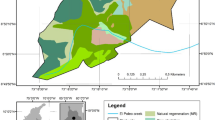Abstract
River or alluvial sand mining is causing a variety of environmental problems in the Itajaí-açú river basin in Santa Catarina State (south of Brazil). When this type of commercial activity degrades areas around rivers, environmental restoration programs need to be executed. In this context, the aim of this study was to assess the evolution of a restored riparian forest based on data on the soil microbial activity and plant biomass growth. A reference site and three sites with soil degradation were studied over a 3-year period. Five campaigns were performed to determine the hydrolysis of the soil enzyme fluorescein diacetate (FDA), and the biomass productivity was determined at the end of the studied period. The variation in the enzyme activity for the different campaigns at each site was low, but this parameter did differ significantly according to the site. Well-managed sites showed the highest biomass productivity, and this, in turn, showed a strong positive correlation with soil enzyme activity. In conclusion, soil enzyme activity could form the basis for monitoring and the early prediction of the success of vegetal restoration programs, since responses at the higher level of biological organization take longer, inhibiting the assessment of the project within an acceptable time frame.




Similar content being viewed by others
References
Adam, G., & Duncan, H. (2001). Development of a sensitive and rapid method for the measurement of total microbial activity using fluorescein diacetate (FDA) in a range of soils. Soil Biology and Biochemistry, 33, 943–951.
APHA, AWWA, & WPCF. (1995). Standard methods for the examination of water and wastewater (19th ed. Section 8220). Washington, DC: American Public Health Association, American Water Works Association and Water Pollution Control Federation.
Cardinali, A., Carletti, P., Nardi, S., & Zanin, G. (2014). Design of riparian buffer strips affects soil quality parameters. Applied Soil Ecology, 80, 67–76.
Carlson, J., Saxena, J., Basta, N., Hundal, L., Busalacchi, D., & Dick, R. P. (2015). Application of organic amendments to restore degraded soil: Effects on soil microbial properties. Environmental Monitoring and Assessment, 187, 109–124.
Collins, B., & Dunne, T. (1990). Fluvial geomorphology and river-gravel mining: A guide for planners, case studies included . San Francisco: California Department of Conservation, Division of Mines and Geology.Special Publication #98
Cooke, H. A., & Zack, S. (2009). Use of standardized visual assessments of riparian and stream condition to manage riparian bird habitat in eastern Oregon. Environmental Management, 44, 173–184.
El-Keblawy, A., & Ksiksi, T. (2005). Artificial forests as conservation sites for the native flora of the UAE. Forest Ecology and Management, 213, 288–296.
EMBRAPA. (1999). Manual de análises químicas de solos, plantas e fertilizantes. Brasília: Empresa Brasileira de Pesquisa Agropecuária.
García-Ruiz, R., Ochoa, V., Hinojosa, M. B., & Carreira, J. Á. (2008). Suitability of enzyme activities for the monitoring of soil quality improvement in organic agricultural systems. Soil Biology and Biochemistry, 40, 2137–2145.
Gris, D., Temponi, L. G., & Marcon, T. R. (2012). Native species indicated for degraded area recovery in western Paraná, Brazil. Revista Árvore, 36, 113–125.
Langer, W. H. (2003). A general overview of the technology of in-stream mining of sand and gravel resources, Associated Potential Environmental Impacts, and Methods to Control Potential Impacts: U.S. Geological Survey Open-File Report 02–0153, Denver, CO, 44 p.
Langer, W. H., & Kolm, K. E. (2001). A systems approach to characterize and evaluate environmental impacts from aggregate mining. In P. Kuula-Väisänen & R. Uusinoka (Eds.), Aggregate 2001 – Environment and economy (pp. 401–406). Tampere: Tampere University of Technology Publication n° 51.
Lee, K. E. (1994). The functional significance of biodiversity in soils. In: Word Congress of Soil Science, Acapulco. Annals of International Society of Soil Science, pp. 168–182
Oliveira, V. C., Trindade, R. C., Carvalho-Filho, O. M., & Costa, J. L. S. (2007). Atividade Microbiana Enzimática (FDA) como Bioindicadora da Qualidade de Solos para o Monitoramento Ambiental em Agroecossistemas do Semi-Árido. Resumos do II Congresso Brasileiro de Agroecologia. Revista Brasileira de Agroecologia, 2, 894–897.
Pankhurst, C. E., Doube, B. M., & Gupta, V. V. S. R. (1997). Biological indicators of soil health: Synthesis. In C. E. Pankhurst, B. M. Doube, & V. V. S. R. Gupta (Eds.), Biological indicators of soil health (pp. 419–435). Wallingford: CAB International.
Polette, M., & Vianna, L. F. (2006). An integrated coastal zone management plan for zoning marine touristic area in northern-central coast of Santa Catarina state/southern Brazil. Proceendigs of the 8th international coastal symposium. Journal of Coastal Research, 39, 1000–1002.
Schnürer, J., & Rosswall, T. (1982). Fluorescein diacetate hydrolysis as a measure of total microbial activity in soil and litter. Applied Environmental Microbiology, 43, 256–1261.
Schumacher, T. E., Eynard, A., & Chintala, R. (2015). Rapid cost-effective analysis of microbial activity in soils using modified fluorescein diacetate method. Environmental Science and Pollution Research, 22, 4759–4762.
Silva, M., Siqueira, E. R., & Costa, J. L. S. (2004). Hidrólise de diacetato de fluoresceína como bioindicador da atividade microbiológica de um solo submetido a reflorestamento. Ciência Rural, 34, 1493–1496.
Sofi, J. A., Bhat, A. G., Kirmai, N. A., Wani, J. A., Lone, A. H., Ganie, M. A., & Dar, G. I. H. (2016). Soil quality index as affected by different cropping systems in northwestern Himalayas. Environmental Monitoring and Assessment, 188, 161–173.
Acknowledgements
C.M. Radetski gratefully acknowledges the grants awarded by CNPq-Brazilian National. Council for Scientific and Technological Development (Grant No. 302798/2013-7).
Author information
Authors and Affiliations
Corresponding author
Rights and permissions
About this article
Cite this article
Venson, G.R., Marenzi, R.C., Almeida, T.C.M. et al. Restoration of areas degraded by alluvial sand mining: use of soil microbiological activity and plant biomass growth to assess evolution of restored riparian vegetation. Environ Monit Assess 189, 120 (2017). https://doi.org/10.1007/s10661-017-5852-3
Received:
Accepted:
Published:
DOI: https://doi.org/10.1007/s10661-017-5852-3




